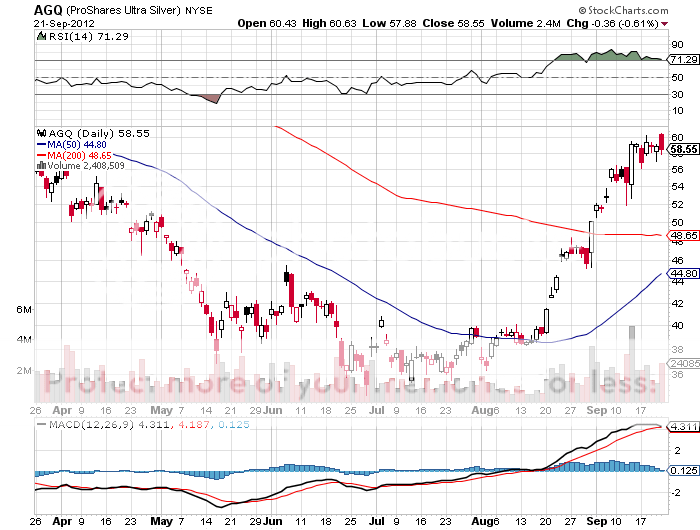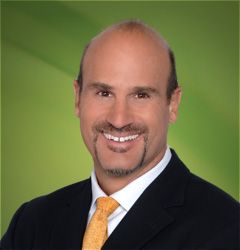
To the dozens of subscribers in Iraq, Afghanistan, and the surrounding ships at sea, thank you for your service! I think it is very wise to use your free time to read my letter and learn about financial markets in preparation for an entry into the financial services when you muster out. Nobody is going to call you a baby killer and shun you, as they did when I returned from Southeast Asia four decades ago. In fact, employers have been given fantastic tax breaks and other incentives to hire you.
I have but one request. No more subscriptions with .mil addresses, please. The Defense Department, the CIA, the NSA, Homeland Security, and the FBI do not look kindly on private newsletters entering the military network, even the investment kind. If you think civilian spam filters are tough, watch out for the military kind! And no, I promise that there are no secret messages embedded with the stock tips. ?BUY? really does mean ?BUY.? ?Sell? means ?Sell? too.
If I did not know the higher ups at these agencies, as well as the Joints Chiefs of Staff, I might be bouncing off the walls in a cell at Guantanamo by now. It also helps that many of the mid-level officers at these organizations have made a fortune with their meager government retirement funds following my advice. All I can say is that if the Baghdad Stock Exchange ever become liquid, I'm going to own it.
Where would you guess the greatest concentration of readers The Diary of a Mad Hedge Fund Trader is found? New York? Nope. London? Wrong. Chicago? Not even close. Try a ten mile radius centered on Langley, Virginia, by a large margin. The funny thing is, half of the subscribing names coming in are Russian. I haven't quite figured that one out yet. Did we hire the entire KGB at the end of the cold war? If we did, it was a great move. Those guys were good.
So keep up the good work, and fight the good fight. But please, only subscribe to my letter with personal Gmail, Yahoo, or Hotmail addresses. That way my life can become a lot more boring. Oh, and by the way, Langley, you're behind on your bill. Please pay up, pronto, and I don't want to hear whining about any damn budget cuts!
I Want My Mad Hedge Fund Trader!
The Middle Kingdom currently has 12 operational plants generating 12 gigawatts accounting for 2.3% of the country?s power. Another 23 are currently under construction. It plans to add ten a year for the next decade, taking them up to 70 Gigawatts by 2020, and a staggering 400 gigawatts by 2050.
That?s nearly the total power generated in China today. This will make China the world?s largest consumer of yellow cake (U3H8) for fuel. Canadian, American, and Australian uranium miners please take note.
The goal is to meet the country?s insatiable demand for more electricity, as well as making a major dent in new greenhouse gases contributing to global warming. The China Guangdong Nuclear Power Group in the Southern part of the country is using imported French designs with proven track records. But the China National Nuclear Corporation in the North is using riskier Russian designs, and its president was recently arrested on corruption charges (see below). China plans to start using solely its own designs in the near future.
One wonders if these plants will perform as badly as the country?s poorly constructed school buildings when an earthquake hits. As nuclear plants are sited next to major cities, an accident could make Chernobyl look like a cake walk.
It is the end of the school year at the University of California at Berkeley, and the unenviable task of moving my son, a senior, out of his hovel for the holidays fell to me.
When I arrived, I was stunned to find nothing less than a war zone. Both sides of every street were lined with mountains of trash, the unwanted flotsam and jetsam cast aside by departing students. Computer desk, stained mattresses, broken lava lamps, and an assortment of heavily worn Ikea furniture were there for the taking. Newly arriving students were sifting through the piles looking for that reusable gem. Diminutive Chinese teenagers were seen pushing massive suitcases on wheels down the sidewalk on their way back to Shanghai, Beijing, and Hong Kong. The university attempted to bring order to the chaos by strategically placing dumpsters on every block, but they were rapidly filled to overflowing.
It was all worth it because of the insight it gave me into one of my favorite, least know leading economic indicators. When I picked up the truck at U-HAUL, the lot was absolutely packed with returned vehicles, and there were more parked on both sides of the streets. The booking agent told me there is a massive influx of people moving into California from the Midwest and the Northwest, with the result that lots all over the San Francisco Bay Area are filled to capacity.
I love this company because in addition to providing a great service, they get the first indication of any changes to the migratory habits of Americans. The last time I saw this happen was after the dotcom bust, when thousands of tech savvy newly unemployed pulled up stakes in the foggy city and moved to Lake Tahoe to work in ?the cloud.? Bottom line: California is enjoying a resurgence of hiring and new economic growth. This is what the stock market is seeing that you and I can?t.
Want a Great Deal on a Used Lava Lamp?
On my recent trip to Oregon I met with venture capital investors in NuScale Power, which is trailblazing, the brave new world of ?new? nuclear. Their technology has been pioneered by Dr. Jose Reyes, dean of the School of Engineering at Oregon State University in Corvallis.
This is definitely not your father?s nuclear power plant. The company has applied for design certification with the Nuclear Regulatory Commission for a mini light water reactor with a passive cooling system rated at 45 megawatts. The idea is to site a dozen of these together which in aggregate can generate 540 Megawatts, little more than half the size of the old 1 gigawatt monsters.
Running a dozen small reactors instead of one big one makes for vastly easier operation and maintenance, as individual units can be brought on and offline as needed. Small size also eliminates the need for gargantuan, expensive containment structures. This power source runs at night, when solar and wind plants are offline. Modular design makes mass production of these units economical. Once certification, approval, permitting, and construction are complete, we can expect to see the NuScale plants running by 2018. After all, if something similar works in nuclear powered submarines and aircraft carriers, why not in industrial zones on the outskirts of town? For more on NuScale?s innovative efforts visit their website by clicking here at http://www.nuscalepower.com/.
Yesterday, I wrote about the Nevadan wrinkle in the housing crisis where distressed homeowners are letting their horses go wild to make their mortgage payment. Now neighboring California is facing a Chihuahua glut, where evicted homeowners are handing over their pets to animal shelters. The diminutive Mexican canine enjoyed a boom in popularity in recent years, thanks to movies like Beverly Hills Chihuahua and Legally Blonde.? Celebrities, like Paris Hilton, have also helped promote the breed, flaunting one in front of the paparazzi. Animal shelters in the Land of Fruits and Nuts have been so overwhelmed they have had to ship the ultra cute, but utterly useless animals to pounds as far away as Toronto. Will the unintended consequences of Greenspan?s low interest policy never end? Give the poor Chihuahua?s a break!
I am looking to hear from the readers who have enjoyed the most profitable trading experience following my Trade Alerts in 2012. I am interested in learning about the specific trades you placed, the amount of money you made, and how the service has enhanced your trading experience.
The winner will receive a free one year renewal to Global Trading Dispatch, which currently costs $3,000. I will interview the winner live at my next biweekly strategy webinar on Wednesday, October 10 at 12:00 noon EST.
Please email your entries to me at madhedgefundtrader@yahoo.com, put ?CONTEST ENTRY? in the subject line and include your name and phone number at the bottom of your message. This contest is open to paid subscribers only. This should be fun. I Look forward to hearing from you.
John Thomas
?China is the classic emerging market roach motel, except it?s a really big one. It is very difficult to earn adequate returns on capital and to get your capital back as a westerner,? said Jim Chanos of hedge fund Kynikos Associates.
Thank you so much for the newsletter you sent out ? I really enjoyed reading it. You?ve got quite a unique and engaging style as a writer, world traveler/lecturer and of course, trader. I?m glad to see your performance numbers catapulted you to the top percentile of the hedge fund ranks ? all the best on your future endeavors.
Noemi
San Jose, CA
With silver back in the headlines, I thought I'd touch base with a wizened and grizzled old veteran who still remembers the last time the biggest bubble in history popped for the white metal. That would be Mike Robertson, who runs Robertson Wealth Management, one of the largest and most successful registered investment advisors in the country.
Mike is the last surviving silver broker to the Hunt Brothers, who in 1979-80 were major players in the run up in the 'poor man's gold' from $11 to a staggering $50 an ounce in a very short time. At the peak, their aggregate position was thought to exceed 100 million ounces.
Nelson Bunker Hunt and William Herbert Hunt were the sons of the legendary HL Hunt, one of the original East Texas oil wildcatters, and heirs to one of the largest fortunes of the day. Shortly after president Richard Nixon took the U.S. off the gold standard in 1971, the two brothers became deeply concerned about financial viability of the United States government. To protect their assets, they began accumulating silver through coins, bars, the silver refiner, Asarco, and even antique tea sets ? and when they opened, silver contracts on the futures markets.
The brothers? interest in silver was well known for years, and prices gradually rose. But when inflation soared into double digits, a giant spotlight was thrown upon them, and the race was on. Mike was then a junior broker at the Houston office of Bache & Co., in which the Hunts held a minority stake, and handled a large part of their business.?The turnover in silver contracts exploded. Mike confesses to waking up some mornings, turning on the radio to hear silver limit up, and then not bothering to go to work because he knew there would be no trades.
The price of silver ran up so high that it became a political problem. Several officials at the CFTC were rumored to be getting killed on their silver shorts. Eastman Kodak (EK), whose black and white film made them one of the largest silver consumers in the country, was thought to be borrowing silver from the Treasury to stay in business.
The Carter administration took a dim view of the Hunt Brothers' activities, especially considering their funding of the ultra-conservative John Birch Society. The Feds viewed it as a conspiratorial attempt to undermine the U.S. government. It was time to pay the piper.
The CFTC raised margin rates to 100%. The Hunts were accused of market manipulation and ordered to unwind their position. They were subpoenaed by Congress to testify about their motives. After a decade of litigation, Bunker received a lifetime ban from the commodities markets, a $10 million fine, and was forced into a Chapter 11 bankruptcy.
Mike saw commissions worth $14 million in today's money go unpaid. In the end, he was only left with a Rolex watch, his broker's license, and a silver Mercedes. He still ardently believes today that the Hunts got a raw deal, and that their only crime was to be right about the long term attractiveness of silver as an inflation hedge.
Nelson made one of the great asset allocation calls of all time and was punished severely for it. There never was any intention to manipulate markets. As far as he knew, the Hunts never paid more than the $20 handle for silver, and that all of the buying that took it up to $50 was nothing more than retail froth.
Through the lens of 20/20 hindsight, Mike views the entire experience as a morality tale, a warning of what happens when you step on the toes of the wrong people.
And what does the old silver trader think of prices today? Mike saw the current collapse coming from a mile off. He thinks silver is showing all the signs of a broken market, and doesn't want to touch it until it revisits the $20's. But the white metal's inflation fighting qualities are still as true as ever, and it is only a matter of time before prices once again take another long run to the upside.
Silver is Still a Great Inflation Hedge
Sometimes market moves call for options, and I?ve used a lot of them recently. Can options be profitable? The proof is in the pudding as my strategies have paid off handsomely. However, I do get a lot of questions about option strategies and how best to place trades. In an effort to help my readers improve their profits I have scheduled an options training seminar for the first week in November ? and I?ve gone one better.
This options training session will be a half-day session run by the folks at TradeMONSTER, and will be part of a 2-day economic symposium run by the HS Dent group of Harry Dent fame. I?ve been a guest speaker at this event in the past and will be part of their lineup at a later session as well. The combined program is a two-day information and education feast. The options training will be the second half of the second day of the symposium.
TradeMONSTER is the trading platform run by my friends, the Najarian brothers, the guys on CNBC with ponytails that report from the old exchange in Chicago. Their representative will discuss options in general then get into the nitty gritty of strategies like the ones I use, although I don?t often use the official names, like bull put spread, bear call spread, verticals, and even Iron Condors. Don?t get lost in the vernacular; just know that they will help you sort this out so that you better understand how to take advantage of my research. I?ll be there at the end of the options session to answer questions and share a cocktail.
The economic symposium put on by HS Dent, which they call Demographics School, gives you the lay of the land in our economy. It will outline how the economy works and what most likely lies ahead based on how consumers spend money. Here?s a hint ? old people buy less toys and spend more on healthcare, which sounds simple but has profound implications for our country and the world. These trends unfold over a long time period and if you pay attention you can make a lot of money. Short term moves can be very profitable, but you have to keep in mind how the world is shaping up in the background. If you lose sight of the long term, you risk having it run you over.
So here?s the scoop. The 2-day event will be held on Wednesday and Thursday, November 7th and 8th, 2012, in Tampa, FL at the Renaissance Hotel. The cost of the event is typically $1,995, but through my relationship with these two organizations I am able to get my subscribers in for just $895. This includes the symposium, the options training, breakfast and lunch on both days, as well as a cocktail hour. Harry Dent will be on hand Wednesday afternoon and I understand he also sticks around to share a drink. So come to learn as well as share stories and ideas with Harry and me.
To register for the event, click on this link http://www.hsdent.com/madhedge_demospecial.pdf





















